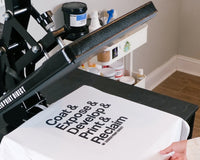Hey Printers,
Today we dive into common myths about plastisol ink. We get so many emails and see a lot of forums with answers that are simply not true. Screen Print Direct® is a team of screen printers that know their stuff (lots of trial and error my friends). Below we clear up confusion and help you focus on the tips and tricks of the trade that drive real results.
Myth #1: My plastisol ink is ready to use right out of the container!
Err...False. Inks are never truly ready to use. Plastisol inks should be stirred for several reasons. First, screen printing plastisol ink thickens as it sits on the shelf. As ink thickens it produces a “false body." False Body can be detected when you open a container and try to scoop ink but it’s so thick it forms a mushy block. Luckily there is a simple fix. Stirring! This will help the ink come back to a fluid thinner body. It can sometimes take 5 minutes to get a white ink to its true print body. Some people even use a drill to stir up the ink faster. Secondly, when an ink sits on the shelf too long the oil starts to separate from the pigment. Again, stir! It is important that you mix that together to get your ink back to a nice creamy texture.
Myth #2: I can use one white ink for cotton, 50/50 and tri-blends!
Now there is a bit of a debate here. Some screen printers will use 1 ink for everything and claim it works and other printers will use several different inks for different applications.
Sure, there are low bleed inks that are used on everything from your 100% cotton to pure poly inks; but some poly inks have dye blockers to help keep your garments from having dye migration issues. These blockers can sometimes have a bad effect with the dyes on 100% cotton shirts resulting in “ghost” images.
Under-base white is also not the same as a standard printing white. Under-base white was not formulated to be a top vibrant color. Under-base was made to be an under-base as it lays nicely under other colors. Similarly, standard white plastisol ink will not perform like an under-base and you may have a rougher hand if you print another color on top of a standard white, hence we suggest an under-base.
Myth #3: Using an ink reducer will reduce the ink opacity.
This is not true! In fact, you can reduce a high opacity ink without reducing the opacity of the print. Sounds complicated I know but stay tuned below and you’ll be an opacity pro.
Let’s say you want to print on a black shirt. When printing on black you will want more opacity and coverage from your ink as well as high detail. To achieve this, you will want to use a higher/finer mesh count for your print run. We don't suggest anything higher than a 160 mesh count.
Ok, now you’re ready to print and grab your white ink but it’s so thick it’s been sitting on the shelf for a while and no matter how much you stir, the darn ink won’t print through that fine mesh count.
Cue in our hero, Curable Reducer. You add 2-5% of reducer by weight and now you have an ink you can work with. Right about now, we are sensing some objections… won’t curable reducer reduce my opacity and give me less coverage on the black shirt. No, not exactly! Now that you have reduced the ink, you didn’t affect opacity, you affected viscosity (thickness). Now you can lay down more ink on your screen because it’s a wee bit thinner and friendlier to work with, unlike your co-worker Karen.
Myth #4: I have been printing for years I know how to print; I don’t need any instructions on plastisol ink.
Pause. You should always read the instructions of the tech data sheet because products vary from different manufacturers. Some inks are specialty inks and require different handling. Puff, glitters, low temperature cure plastisol inks are all products we highly recommend doing your research on before printing. For example, glitter screen printing inks require a different mesh count. Getting your shop set up for a print for a job and not being able to pull your ink through the mesh when the shirts are due tomorrow is not a fun place to be. Do your due diligence and watch your shop efficiency soar.
Myth #5: You should always print a base on dark shirts with highly opaque ink on top so the design comes out nice and bright!
You do not need to use highly opaque ink over a base. First, highly opaque inks are meant to be printed alone without the use of a base. Second, highly opaque inks cost a lot more! So, if you print expensive ink on top of another ink you are going to be paying a lot of money in ink per shirt. We consider this overkill. If you are using a base a standard plastisol ink will give you great opaque coverage.
Myth #6: I already used a poly ink, that’s it, there’s nothing else I can do to help avoid dye migration.
That’s a big ERRRR myth alert, myth alert!!!!! There are a few more tricks you can pull out of your sleeve.
- You can adjust your flash height and temp to make sure that you are not over flashing. Remember your platens are heating up as well getting hotter and hotter so your poly fabric is getting heat from the flash unit as well as being on the hot platen.
- Make sure that your film of ink reaches the 320° - 330° and does not exceed that (If you are using a Low Temp Ink you can go well over the 270° cure temp). Once you go above that, the shirt dyes get too hot and you will notice discolored ink days later.
- Another trick that can be used for combating dye migration is checking the garment itself. What do we mean? You are going to put the garment through a quick text. First, grab two pieces of white cloths. Now let's say you want to print on a red shirt. Grab one cloth and rub the shirt with it a few times and see if any dye transfers then repeat with the other cloth, except this time a little damp. If no dye transfer or a very minimal amount, you are in the clear. This means you most likely won’t experience any issues provided you don’t over cure. If you do get a substantial amount of dye color this might not be the ideal garment to print on.
Myth #7: I don’t need to do any cure tests, one minute under my flash dryer is enough.
That’s not true and bad advice. It is very important to do proper cure tests. Countless customers email and tell us their ink just “fell off” or “washed away.” No it didn't.
There are several testing tactics you can do to ensure your ink is cured properly.
- Get a laser temperature gun. You can get them fairly cheap. We also sell them here at SPD
- Use temperature strips, these are strips like tape you place on your shirt next to your design area, when it goes through the dryer
- Stretch test! This is probably the easiest one to do, print your garment cure it and simply stretch it. If your ink starts to crack it's not cured p Exception: If printing with discharge ink don’t be alarmed! Discharge ink is printed into the fabric so if you stretch the garment the ink will stretch as well. For more information on discharge printing please read here.
- Lastly, do a wash test. Yes, it's time consuming but a 100% guarantee your customer will be satisfied with their order. Run it through the laundry as you do your own garments. You don't want to receive the dreaded call that 100 shirts have been stripped of ink after a wash.
Myth #8: Low temperature plastisol inks can't be mixed with normal plastisol inks.
Wrong. You can mix a low temperature cure plastisol with a standard color plastisol. You just need to make sure that your cure time is going to be that of the standard ink. Example: Plastisol low temperature ink mixed with a standard 320° F cure ink needs to be cured at 320° F.
Myth #9: I have a low bleed ink I can now safely print on polys
Hold your horses. Low bleed is not the same as no bleed so make sure that if you are going to print on straight poly that you have a no bleed polyester ink. If you use a low bleed there is still a chance that you will encounter dye migration.
Myth #10: Low temperature cure plastisol is going to cure way faster!
Unfortunately, that's not the case. Now, it does cure at a lower temperature but that is not the same as speed. You still need to cure ink for at least 60 seconds at its curing temperature.
Let's Talk
Remember, we are here to help! Drop a comment below or email our support team at info@screenprintdirect.com








1 comment
Kat
I am trying to screen print on Jersey stretch shirts and am trying to figure out if an additive being added to my white low bleed plastisol ink will help the print stay put. My first time trying to screen print, I used a water base ink and the ink didn’t dry and whatever stayed in tact to the Jersey washed right off. What am I doing wrong? Any help or advice is much appreciated.